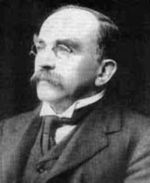- Larmor
-
Sir Joseph Larmor (* 11. Juli 1857 in Magheragall, County Antrim, Nordirland; † 19. Mai 1942 in Holywood, County Down) war ein irischer Physiker und Mathematiker.
Von 1903 bis 1932 war er Professor auf dem Lucasischen Lehrstuhl für Mathematik am Trinity College der University of Cambridge; sein Vorgänger in dieser Position war George Gabriel Stokes, sein Nachfolger wurde Paul Dirac.
Inhaltsverzeichnis
Werk
Larmor veröffentlichte 1897 [1] als Erster die Lorentz-Transformation, zwei Jahre vor Hendrik Antoon Lorentz und acht Jahre vor Albert Einstein. Er sagte dabei den Effekt der Zeitdilatation voraus und bestätigte die FitzGerald-Lorentzkontraktion, vorausgesetzt die Moleküle werden durch elektromagnetische Kräfte zusammengehalten. 1900 [2] präsentierte er die Transformationen in etwas klarerer Gestalt, wobei er jedoch wie Lorentz, aber im Gegensatz zu Einstein, die damit verbundenen Effekte als dynamisch und nicht kinematisch verstand. Obwohl er die Relativitätstheorie für kurze Zeit befürwortete, lehnte er sie später ab, da er die Raumzeitkrümmung ablehnte und meinte, dass die absolute Zeit für die Astronomie unverzichtbar sei.
Larmor nahm an, dass man sich den Äther als ein homogenes, fluides Medium vorstellen kann, das inkompressibel und elastisch sei. Wie Lorentz glaubte er, dass die Bewegung von Äther und Materie streng voneinander zu trennen seien. Dabei vereinigte Larmor Kelvins Vortex-Äthermodell mit seiner Theorie. Die Materie wurde von ihm wie Lorentz als Strom von Partikeln bzw. Elektronen geschildert. Dabei ging Larmor davon aus, dass Materie bzw. Elektronen keine eigene Substanz besitzen und nur eine besondere Form des Äthers seien.
Larmor errechnete die Rate der Energiestrahlung eines beschleunigten Elektrons und er erklärte die Trennung der Spektrallinien in einem magnetischen Feld durch die Oszillationen der Elektronen.
Auszeichnungen
1880 wurde Larmor der Senior Wrangler der University of Cambridge, die ihn im gleichen Jahr mit dem Smith's Prize auszeichnete; 1898 verlieh sie ihm den Adams Prize.
1892 wurde er als Mitglied („Fellow“) in die Royal Society gewählt, die ihm 1915 die Royal Medal und 1921 die Copley Medal verlieh. 1909 wurde er zum Ritter geschlagen. Die London Mathematical Society zeichnete ihn 1914 mit der De-Morgan-Medaille aus.
1911 wurde er auswärtiges Mitglied der Accademia Nazionale dei Lincei in Rom.
Der Mondkrater Larmor wurde nach ihm benannt.
Veröffentlichungen
Larmor gab die gesammelten Werke von George Gabriel Stokes und Lord Kelvin heraus und er verfasste Nachrufe zu Stokes, Kelvin und Josiah Gibbs.
- 1887, „On the direct applications of first principles in the theory of partial differential equations,“ Proceedings of the Royal Society.
- 1891, „On the theory of electrodynamics,“ Proceedings of the Royal Society.
- 1892, „On the theory of electrodynamics, as affected by the nature of the mechanical stresses in excited dielectrics,“ Proceedings of the Royal Society.
- 1893-97, „Dynamical Theory of the Electric and Luminiferous Medium,“ Proceedings of the Royal Society; Philosophical Transactions of the Royal Society. Reihe aus 3 Artikeln mit Larmors physikalischer Theorie des Alls.
- 1894, „Least action as the fundamental formulation in dynamics and physics,“ Proceedings of the London Mathematical Society.
- 1896, „The influence of a magnetic field on radiation frequency,“ Proceedings of the Royal Society.
- 1896, „On the absolute minimum of optical deviation by a prism,“ Proceedings of the Cambridge Philosophical Society.
- J. Larmor: On a Dynamical Theory of the Electric and Luminiferous Medium, Part 3, Relations with material media. In: Phil. Trans. Roy. Soc.. 190, 1897, S. 205-300. . Enthält die Lorentztransformation.
- 1898, „Note on the complete scheme of electrodymnamic equations of a moving material medium, and electrostriction,“ Proceedings of the Royal Society.
- 1898, „On the origin of magneto-optic rotation,“ Proceedings of the Cambridge Philosophical Society.
- J. Larmor: Aether and Matter. Cambridge University Press, 1900. . Enthält ebenfalls die Lorentztransformation.
- 1903, „On the electrodymanic and thermal relations of energy of magnetisation,“ Proceedings of the Royal Society.
- 1907, „Aether“ in Encyclopædia Britannica, 11th ed. London.
- 1908, „William Thomson, Baron Kelvin of Largs. 1824-1907“ (Obituary). Proceedings of the Royal Society.
- 1924, „On Editing Newton,“ Nature.
- 1927, „Newtonion time essential to astronomy,“ Nature.
- 1929, „Mathematical and Physical Papers. Cambridge Univ. Press.
Siehe auch
- Geschichte der Lorentz-Transformation
- Geschichte der speziellen Relativitätstheorie
- Lorentzsche Äthertheorie
- Larmorfrequenz
- Larmor-Radius
Sekundäre Quellen
- Macrossan, M. N.: A Note on Relativity Before Einstein. In: Brit. J. Phil. Sci.. 37, 1986, S. 232-234.
- Warwick, Andrew, "On the Role of the FitzGerald-Lorentz Contraction Hypothesis in the Development of Joseph Larmor's Electronic Theory of Matter". Archive for History of Exact Sciences 43 (1991): 29-91.
- Darrigol, O.: The Electron Theories of Larmor and Lorentz: A Comparative Study. In: Historical Studies in the Physical and Biological Sciences. 24, 1994, S. 265–336.
Weblinks
- Joseph Larmor im MacTutor History of Mathematics archive (englisch)
- "A very short biography of Joseph Larmor"
- "Ether and field theories in the late 19th century" At VictorianWeb: History of science in the Victorian era
- "Papers of Sir Joseph Larmor". Janus, University of Cambridge.
PND: Datensatz zu Joseph Larmor bei der DNB – Keine Treffer im DNB-OPAC, 7. Mai 2008 Einzelnachweise
- ↑ J. Larmor: On a Dynamical Theory of the Electric and Luminiferous Medium, Part 3, Relations with material media. In: Phil. Trans. Roy. Soc.. 190, 1897, S. 205-300.
- ↑ J. Larmor: Aether and Matter. Cambridge University Press, 1900.
Personendaten NAME Larmor, Joseph KURZBESCHREIBUNG irischer Physiker und Mathematiker GEBURTSDATUM 11. Juli 1857 GEBURTSORT Magheragall, County Antrim STERBEDATUM 19. Mai 1942 STERBEORT Holywood, County Down
Wikimedia Foundation.

